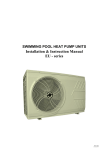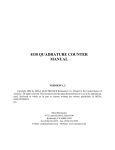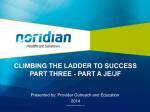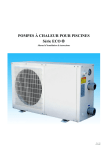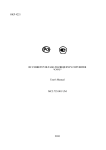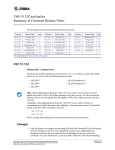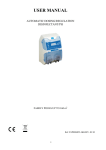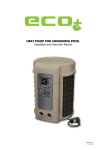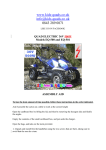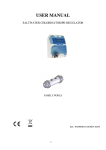Download Duratech Eco User Manual
Transcript
Page 1 SWIMMING POOL HEAT PUMP UNIT ECO - series Installation & Instruction manual Rev. 1.00 28.11.2007 Page 2 ECO heat pump Contents SWIMMING POOL HEAT PUMP UNIT 1 CONTENTS 2 1. PREFACE 3 2. SPECIFICATIONS 4 2.1 Performance data of ECO Swimming Pool Heat Pump Unit 4 2.2 Dimensions of Swimming Pool Heat Pump 5 3. INSTALLATION OF THE HEAT PUMP UNIT 6 3.1 Installation items: 6 3.2 Heat pump location 6 3.3 How close to the pool? 6 3.4 Check valve installation 7 3.5 Typical configuration 7 3.6 Setting the bypass 8 3.7 Electrical wiring 9 3.8 Initial startup of the unit 9 3.9 Condensation 9 4. GUIDELINES 10 4.1 Water chemistry 10 4.2 Wintering 10 4.3 Spring startup 10 4.4 Owner inspection 11 5. MAINTENANCE AND INSPECTION 12 5.1 Maintenance 12 5.2 Trouble shooting guide 12 5.3 Check list at installation 13 6. DETAILED SPECIFICATIONS 14 6.1 Electrical wiring diagram of the heat pump 14 7. WARRANTY AND RETURN 15 7.1 Warranty 15 7.2 RMA request form 16 2 Page 3 ECO heat pump 1. Preface • In order to provide our customers with quality, reliability and versatility, this product has been made to strict producing standards. This manual includes all necessary information about installation, debugging, discharging and maintenance. Please read this manual carefully before you open or maintain the unit. The manufacturer of this product will not be held responsible if someone is injured or the unit is damaged, as a result of improper installation, debugging or unnecessary maintenance. It is vital that the instructions within this manual are adhered at all times. Qualified personnel must install the unit. • A qualified installer, centre, personnel or an authorized dealer, can only repair the unit. • Maintenance and operation must be carried out according to the recommended time and frequency, as stated in this manual. • Use genuine standard spare parts only. Failure to comply with these recommendations will void warranty. • The Swimming Pool Heat Pump Unit heats the swimming pool water and keeps the temperature constant. Our heat pump has following characteristics: Durable The heating exchanger is made of PVC & Titanium tube, which can withstand prolonged exposure to swimming pool water. Easy operation The unit is very easy to operate: switch it on and set the desired pool water temperature. Quiet operation The unit comprises an efficient rotary compressor and a low-noise fan motor, which guarantees its quiet operation. The unit can heat your swimming pool water when the air temperature is 10°C or higher. Low cost The operational cost is very low due to its high performance. 3 Page 4 ECO heat pump 2. Specifications 2.1 Performance data of ECO Swimming Pool Heat Pump Unit Unit Heating Capacity Power Input Model ECO-3 ECO-5 ECO-8 ECO-10 ECO-12 kW 3,0 5,0 8,0 10,0 12,0 BTU/h 10200 17000 27300 34000 42500 kW 0,73 0,98 1,63 2,0 2,4 3 Maximum Pool Volume m 12 18 30 40 60 Running Current A 2,9 4,5 7,5 9,1 12,0 4,1 5,1 4,9 5,0 5,0 220-240/1/50 220-240/1/50 220-240/1/50 220-240/1/50 220-240/1/50 COP Power Supply V/Ph/Hz Controller Mechanical control Condenser Titanium heat exchanger Compressor Quantity Compressor Refrigerant Refrigerant quantity Kg Fan quantity Fan Power Input Fan Speed W RPM Fan Direction Noise at 2m Water Connection Nominal Water Flow Water Pressure Drop (max) Unit Net Dimensions Unit Shipping Dimensions Net Weight / Shipping Weight 1 1 1 1 1 rotary rotary rotary rotary rotary R407C R407C R407C R407C R407C 0,5 0,8 1,0 1,3 1,3 1 1 1 1 1 20 25 25 30 30 950 horizontal 900 horizontal 900 horizontal 890 horizontal 890 horizontal dB(A) 51 54 55 57 57 mm 50 50 50 50 50 m /h 3-5 4-6 4-7 4-7 4-7 kPa 10 10 12 15 15 770/300/490 936/360/550 936/360/550 1010/370/615 1010/370/615 mm 825/315/525 1090/390/580 1090/390/580 1170/415/645 1170/415/645 Kg 32/36 40/46 50/54 58/65 60/67 3 L/W/H mm L/W/H Measurement conditions: Dry bulb: 24 ℃ , Wet bulb: 19 ℃, water inlet temperature 27 ℃ 4 Page 5 ECO heat pump 2.2 Dimensions of Swimming Pool Heat Pump ECO-3 ECO-5 ECO-8 ECO-10 ECO-12 A 213 280 280 301 301 B 293 360 360 370 370 C 770 936 936 1010 1010 D 810 970 970 1050 1050 5 E 80 80 80 83 83 F 200 200 200 270 270 G 455 521 521 585 585 H 485 551 551 615 615 Page 6 ECO heat pump 3. Installation of the heat pump unit 3.1 Installation items: The factory only provides the heat pump unit; the other items including an eventual bypass, in the illustration are necessary parts for the water system, provided by users or the installer. Attention: Please follow these steps when installing the heat pump: 1. All feeding of chemicals to the pool water has to be done downstream of the heat pump. 2. Install a bypass when the flow of the pool pump is more then 20% above the rated flow of the heat exchanger of the heat pump. 3. Install the heat pump above the level of the pool water. 4. Install the heat pump on a solid foundation and use the damping rubbers to eliminate vibrations and noise. 5. Always keep the unit straight up. If the unit has been tilted or put on his side, allow 24h before starting the unit. 3.2 Heat pump location The unit may be installed virtually anywhere outdoors. For indoor pools please consult your supplier. DO NOT put the unit in an enclosed area with a limited air volume where the unit discharge air will be re-circulated. DO NOT put the unit next to shrubs, which can block the air inlet. Such locations deny a continuous source of fresh air, which reduces its efficiency and may prevent adequate heat delivery. The picture below give the minimum required distances from each side of the heat pump. Install the heat pump where you have the best access to warm air during the swimming season 3.3 How close to the pool? Install the heat pump as close to the swimming pool as possible to minimize the loss of heat through the piping. Put it on a solid base and place the rubber blocks under the heat pump to eliminate vibrations. 6 Page 7 ECO heat pump 3.4 Check valve installation Caution –Placement of the chlorinator, water balance equipment, and the placement of injectors of chemicals, are very important aspects of the installation. All addition of chemicals have to be done downstream from the heat pump. Failure to protect the heat pump unit from chemical damage is not covered under the warranty. 3.5 Typical configuration Note: the above piping connection is only an example for demonstration 7 Page 8 ECO heat pump 3.6 Setting the bypass With the bypass set correctly, your heat pump will deliver its best performance. The bypass has to be built as show below: F r o m T o p o o l f i l t e r OUT IN HEATPUMP Setting the valves of the by-pass: • • • set all 3 valves entirely open slightly close valve 1 (see also 3.8) close valve 3 about half way to adjust the refrigerant pressure 8 VALVE 1 Slightly closed (water pressure increased with just 100 to 200 gr) VALVE 2 Completely open VALVE 3 Half way open Page 9 ECO heat pump 3.7 Electrical wiring Note: - Verify the local power supply and the operating voltage of the heat pump. It is recommended to use a separate circuit breaker (slow type – D curve) for the heat pump together with the proper wiring characteristics (see table below). The current to the heat pump should only be applied when the filter pump is running. For example a relay controlled by the filter pump could be used to activate the current to the heat pump. Further connect the electrical supply to the junction box inside the unit. All ECO heat pumps require single-phase connection. Grounding the heat pump is required to protect you against electrical shock caused by an eventual short circuit inside the unit. Model Power supply (Volt) Circuit breaker (A) Running current (A) Cable diameter (mm2) for cable length max 15m ECO-3 220-240 16 ECO-5 220-240 16 ECO-8 220-240 20 ECO-10 220-240 20 ECO-12 220-240 20 Values in this table are only guidelines. Please check your local regulations. 3,3 4,8 7,5 10 13 1,5 1,5 2,5 2,5 2,5 The heat pump is not equipped with a flow switch or any other kind of water flow detection. Therefore, the heat pump has to be wired electrically together with the filter pump to ensure water flow while the heat pump is running. 3.8 Initial startup of the unit Start up Procedure - after the installation is completed, you should follow these steps: 1. Set the by-pass valve 1 entirely open. Turn on your filter pump. Check for water leaks and verify flow to and from the pool. 2. Turn on the electrical power supply to the unit and turn the unit ON with the switch. Slightly close valve 1 until the heat pump starts. 3. After running a few minutes, check if the air leaving the side of the unit is cooler. 4. Allow the unit and pool pump to run 24 hours per day until desired pool water temperature is reached. When the set temperature is reached, the unit just shuts off. The unit will now automatically restart (as long as your pool pump is running) when the pool temperature drops more than 1 degree Celsius below set temperature. Time Delay - the unit is equipped with a 3-minute built-in delay to protect control circuit components and to eliminate restart cycling and contactor chatter. This time delay will automatically restart the unit approximately 3 minutes after each circuit interruption. Even a brief power interruption will activate this delay and prevent the unit from starting until the 3-minute countdown is completed. Several days are needed to bring the temperature of you swimming pool water to its required value. 3.9 Condensation Since the Heat pump cools down the air about 8 - 12 °C, water may condense on the fins of the evaporator. If the relative humidity is very high, this could be as much as several liters an hour. Sometimes this condensation water is wrongly considered as swimming pool water. 9 Page 10 ECO heat pump 4. Guidelines 4.1 Water chemistry Special care should be taken to keep the chemical balance of your swimming pool within limits: pH 7,0 – 7,4 free chlorine 0,5 – 1,2 mg/l TAC 80 – 120 mg/l salt max 3g/l IMPORTANT: failure to keep the swimming pool water between above limits will void the warranty NOTE: when the concentration of one or more products mentioned above becomes too high, irrevocable damage to your heat pump may occur. Make sure that you always install water treatment equipment after the heat pump. When an automatic chemical feeder is installed in the plumbing, it must be installed downstream of the heat pump. A check valve must be installed between the heat pump and the chemical feeder to prevent back-siphoning of chemically saturated water into the heat pump where it will damage the components. 4.2 Wintering Caution: failure to winterize could cause damage to the heat pump and will void warranty In areas where freezing temperatures occur, you should protect your pump, filter and heat pump from the elements. Perform the following steps to completely drain the heat pump: 1. Turn off the electrical power to the heat pump at the main breaker panel. 2. Shut off the water supply to the heat pump: close valves 2 and 3 on the by-pass completely. 3. Disconnect the water inlet and outlet and let the water drain from the heat pump. 4. Re-connect the water inlet and outlet loosely to prevent debris entering the connections. 4.3 Spring startup If your heat pump has been winterized, perform the following steps when starting the system in the spring: 1. 2. 3. 4. Inspect the system for any debris or structural problems. Connect the water inlet and outlet unions firmly. Turn on the filter pump to supply water to the heat pump. Adjust the by-pass to allow water flow through the heat pump. Turn on the electrical power to the heat pump at the main breaker panel. 10 Page 11 ECO heat pump 4.4 Owner inspection The ECO heat pumps are designed and constructed to provide long performance life when installed and operated properly under normal conditions. Periodic inspections are important to keep your heat pump running safely and efficiently through the years. The following basic guidelines are suggested for your inspection: 1. Make sure the front of the unit is accessible for future service. 2. Keep the surrounding areas of the heat pump clear of all debris. 3. Keep all plants and shrubs trimmed and away from the heat pump. 4. Keep lawn sprinkler heads from spraying on the heat pump to prevent corrosion and damage. Use a deflector if needed. 5. If the unit is installed under a very sharp roof pitch or under a roof without a gutter, a gutter or diverter should be fitted to prevent excessive water from pouring down onto the unit. 6. Do not use the heat pump if any part has been under water. Immediately call a qualified professional technician to inspect the heat pump and replace any part of the control system, which has been submerged. The heat pump will produce condensation (water) while in operation. The heat pump base is designed to allow the condensation to exit through the bottom drain port. The condensation will increase as the outdoor air humidity level increases. Check the following at regular intervals to ensure proper condensate drainage: 1. Visually inspect and clear the bottom drain port of any debris that could clog the port. 2. Keep the air intake area and discharge area clear of debris so the airflow through the heat pump is not restricted. The cooler discharge air should not accumulate and be drawn into the side air intake coils. During normal operation, the heat pump produces ten to twenty liters of condensate per hour. If condensate drainage is above this range during operation or if water continues to drain from the base when the heat pump is not in operation for more than an hour, a leak in the internal plumbing may have occurred. Call a qualified heat pump technician to investigate the problem. NOTE: A quick way to verify that the water running trough the drain is condensation water is to shut off the unit and keep the pool pump running. If the water stops running out of the base pan, it is condensation water. AN EVEN QUICKER WAY - TEST THE DRAIN WATER FOR CHLORINE - if there is no chlorine present, then it's condensation. 11 Page 12 ECO heat pump 5. Maintenance and inspection 5.1 Maintenance • • • • • • Check the water supply to the unit often. Low water flow and air entering into the system should be avoided, as this will diminish the units’ performance and reliability. You should clean the pool/spa filter regularly to avoid damage to the unit as a result of the dirty or clogged filter. The area around the unit should be dry, clean and well ventilated. Clean the side heating exchanger regularly to maintain good heat exchange and to save energy. Only a certified technician should service the operation pressure of the refrigerant system. Check the power supply and cable connection often. Should the unit begin to operate abnormally, switch it off and contact a qualified technician. In winter, please discharge all water from the water pump and other systems to prevent damage from freezing. You should discharge the water at the bottom of the heat pump if the unit will not work for an extended period of time. You should check the unit thoroughly and fill the system with water fully before using it for the first time after a prolonged period of no usage. 5.2 Trouble shooting guide Improper installation will create an electrical hazard, which could result in death or serious injury to pool users, installers, or others due to electrical shock, and may also cause damage to property. DO NOT attempt any internal adjustments inside the heater. 1. Keep your hands and hair clear of the fan blades to avoid injury. 2. If you are not familiar with your pool filtering system and heater: a. Do not attempt to adjust or service without consulting your dealer, professional pool or air conditioning contractor. b. Read the entire installation and users guide before attempting to use, service or adjust the heater or pool filtering system. Note: Turn off power to the unit prior to attempt service or repair. Problem Heat pump not running Cause Solution 1. No electricity 2. Heat pump not turned on 3. Water pump not running 4. Wrong temperature setting 5. Bypass wrong adjusted 6. No gas pressure 7. Time delayed operation 8. Air temperature below 10°C 1. Switch on the electrical power 2. Switch on the heat pump 3. Switch on the water pump 4. Adjust the temperature setting 5. Adjust bypass as shown in manual 6. Call your technician 7. Wait 3 min for heat pump to start 8. Wait until temperature has risen 1. Obstacles blocking air flow 2. Ice on the evaporator 3. By-pass wrong adjusted 4. To much water flow 1. Increase access of fresh air 2. Turn heat pump off (too cold air) 3. Re-adjust the by-pass 4. Adjust the by-pass No sufficient heating 12 Page 13 ECO heat pump 5.3 Check list at installation 13 Page 14 ECO heat pump 6. Detailed specifications 6.1 Electrical wiring diagram of the heat pump 14 Page 15 ECO heat pump 7. Warranty and return 7.1 Warranty 15 Page 16 ECO heat pump 7.2 RMA request form Company: Address: City: Contact: Date: Zip: E-mail: Propulsion Systems contact name: Country: Phone: Fax: Date: Internal use RMA #: Issued by: Return for: Date: Copy of customer’s invoice attached? Other documents attached to RMA request? Description of documents: Invoice no.: Invoice date: Model no.: Serial no.: Problem: Propulsion Systems warranty repair policy: 1. Returns must be shipped freight prepaid. All return shipping charges are your responsibility. 2. Propulsion Systems requires pre-authorization for the return of all products. Products not authorized for return shall be sent back to you at your expense. 3. Propulsion Systems will repair or replace the products and will ship all products free via a carrier of our choice. 4. We will ship, at your expense, via any express carrier service you request. Return procedure: 1. Before calling for an RMA number, please make sure that you have correctly followed the installation instructions and operating procedures located in the user’s guide. 2. Call our Return Merchandise Authorization department and request an RMA request Form. 3. On the RMA Request Form, make sure you have filled in ALL the information fields. 4. For returns within the warranty period, you must add a copy of your original sales invoice to your customer. 5. Send RMA Request Form, sales invoice and other documents (pictures, …) to fax +32-2-706.59.60 or e-mail [email protected]. RMA number will be issued within 24 hours after proper documents have been received. Propulsion Systems may refuse to issue an RMA number in the event of failure to provide the above information mentioned in item (3) and (4). 6. RMA number should be clearly written on the shipping label and the label placed on the shipping box. 7. All unlabeled, mismarked or illegibly marked products will be refused and returned, freight collect. 8. All packages, which appear to be damaged at the time of delivery to Propulsion Systems will be refused “AS IS”. 9. Please be assured that the products sent to Propulsion Systems are the same products for which the number was issued. If the products do not match the products under the assigned RMA number, Propulsion Systems will return all products, freight collect. 10. No return accepted without an RMA number, absolutely no exceptions. 11. RMA number is only valid for 21 calendar days after authorization. We reserve the right to refuse returned item(s) beyond 21 days from the date RMA number is assigned. Out of warranty products: Customers are responsible for the shipping and repair costs. The estimated repair costs will be given after the diagnosis of the returned products. Diagnostic charge is 50,00€ and up. 16
















